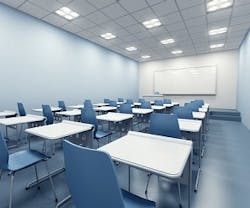Selecting furnishings for educational environments can be challenging. It’s not uncommon for a school’s union lounge to be overflowing with students draped across chairs, couches and floors while a university official tours prospective students, and his or her parents, within same the space.
The furnishings in libraries, offices, conference rooms and other public spaces must meet the needs and aesthetics of students, faculty and visitors, while withstanding excessive use — a tall order for any piece of furniture.
When evaluating furnishings, facility managers should concentrate on four areas:
- Durability and ease of maintenance
- Safety and healthy-atmosphere benefits
- Quietness and comfort
- Contribution towards green initiatives and fit within the assigned budget
Durability and ease of maintenance
In some educational environments, durability and maintenance are two of the most important features. Continual wear and tear from students, especially to seating, makes it increasingly important for facility managers to consider the following:
- ANSI/BIFMA level certification;
- A 10-year warranty on all products; and
- Heavy duty-use seating — tested to 350 pounds — for lounge and high-use areas
Today, educational settings need products that can withstand several years of repeated use. Of these three areas, the most important is understanding the product’s American National Standards Institute/Business and Institutional Furniture Manufacturer’s Association (ANSI/BIFMA) level certification.
This program provides facility managers with peace of mind about a product’s quality and ability to perform over several years. For example, it is not uncommon for a seating piece to undergo 100,000 cycles of weight testing to meet the manufacturer’s standard for sturdiness and quality of design.
Safe and healthy atmosphere
A second key area of focus is creating a safe and healthy environment, and furnishings can play a large role. In places where furniture is touched daily by hundreds of people, low maintenance and easy cleaning are key requirements. The following features give facility managers the ability to quickly and safely clean furnishings and the surrounding environment effectively:
- Laminate arm caps, also resistant to wear and tear, make it easy to wipe away dirt and germs with a bleach solution;
- Stain or moisture-resistant, anti-microbial or bleach-cleanable fabrics;
- Tall steel or metal legs that withstand abuse and allow for easy vacuuming underneath the piece;
- An open space on or near the back to quickly wipe away dirt and crumbs; and
- Closeable storage options to eliminate dust accumulation.
Quiet and comfortable
It may seem like a given that furnishings for education environments should be quiet and comfortable, but surprisingly it can be a forgotten feature when making evaluations. Furniture that is quiet and comfortable means that seats do not make noise when users sit down or get up, drawers and doors don’t squeak or rattle, and users can easily adjust worktops and/or chairs to create a more ergonomic fit. Depending on the requirements of the space, wide arms are gaining popularity in education settings because they offer a convenient space to sit books or laptops.
Interior furnishing selections play a critical role in creating effective-learning environments. Prior to purchase, it is recommended that an organization gauge the comfort and noise level of products by either seeing or experiencing them firsthand.
Green initiatives and budget
Many organizations with new construction or remodeling projects are identifying ways to make buildings more sustainable. To ensure different areas of sustainability are addressed during construction, the most common standard to follow is the U.S. Green Building Council’s (USGBC) Leadership in Energy and Environmental Design (LEED).
The USGBC recently introduced LEED Pilot Credit 43 – Certified Products, which validates the use of third-party products that include transparent documentation about the materials, ingredients, sustainable attributes and life cycle. The credit aims to help facilities increase the use of products that incorporate a holistic approach to sustainability through materials, economic impact and corporate social responsibility. For furniture, some of the most recognized organizations evaluating products’ sustainability include Scientific Certification Systems (SCS), Forestry Stewardship Council (FSC) and ANSI/BIFMA. A complete list of approved certifications and labels is available on the USGBC website, in the LEED Pilot Credit Library, www.usgbc.org.
Because manufacturers use different certification systems it can become confusing to review product attributes using an apples-to-apples comparison. To make it easier, www.ecoScorecard.com brings together all the necessary data and provides the documentation designers and facility managers need to verify if a product meets LEED guidelines.
Conclusion
Through careful analyzing and specifying of products, facility managers increase the likelihood of the final products meeting all facility needs and budget goals. Educational environments must cater to a variety of audiences and by examining products from different perspectives, chances are greater that the solution will meet and exceed all expectations.
Max Holland is Director of Vertical Markets, Kimball Office
